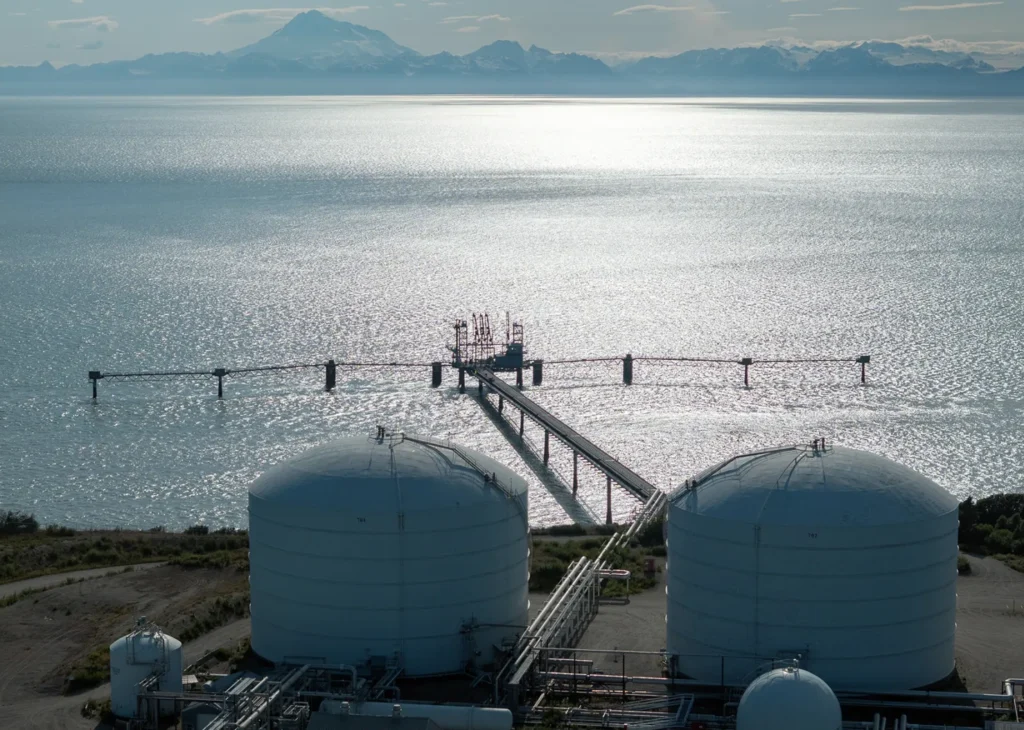Inside the Fight Against Trump’s Alaskan Pipe Dream.

Inside the Fight Against Trump’s Alaskan Pipe Dream
In a xenophobic, hate-filled speech laden with lies and disinformation, President Donald Trump declared before the United Nations General Assembly on Tuesday that climate change is “the greatest con job ever perpetrated on the world,” and railed against all forms of green energy. It was more than just a rant; it is Trump’s policy.
Trump has set his sights on Alaska as a test case for his disastrous “National Energy Dominance” agenda. He wants to double oil production in the state, open up vast new tracts of land to exploitation, kneecap renewable energy, and push construction of what would be one of the largest and most expensive fossil fuel infrastructure projects in the nation. The project includes a massive 800-mile-long gas pipeline stretching from one end of Alaska to the other and a mammoth new export facility to ship gas out of the U.S. to Asia, with an estimated total price tag of over $70 billion.
Last month, I met people across Alaska organizing to resist Trump’s plans. They are pushing back against an agenda they see as catastrophically harmful to their pocketbooks, their way of life, and even their existence. They characterize Trump’s fossil-fueled ambitions as more of a retrograde political ploy than a genuine effort to benefit the state or the nation. Organizing against Trump’s energy agenda has strengthened ties between people often viewed as political adversaries, they explain, providing a sense of community and purpose despite the president’s best efforts to divide the nation.
“No one is throwing up their hands and saying, ‘Well, he’s won,’” Elisabeth Dabney, longtime executive director of the Northern Center in Fairbanks, tells me. “There is hope in being an Alaskan in this moment and seeing that there is solidarity, there is gumption to not give up, and there is strategy. It’s very powerful.”
Opening Alaska’s Oil and Gas Veins
On the first day of his second term in office, Trump signed an expansive executive order, “Unleashing Alaska’s Extraordinary Resource Potential.” Two hundred and nineteen executive orders have followed, but Alaska remains the one and only state to receive such unique and unprecedented attention.
The order seeks to open Alaska’s oil and gas veins to extraction, proposing massive expansions of operations in a state that is already being pummeled by the impacts of the burning of fossil fuels driving the climate crisis, with devastating harms to the local economy, environment, and the survival of its residents.
On August 13, just two days before Trump hosted Russian President Vladimir Putin in Anchorage for a summit that did little to advance peace in Ukraine but did further both presidents’ commitment to fossil-fueled autocracy, residents of Alaska’s capital city of Juneau were evacuating in advance of historic flooding from nearby melting glaciers.

Andy Moderow on the Taylor Skiff on Blackstone Bay, Alaska, on Aug. 18, 2025. Antonia Juhasz
After reporting on the summit, I boarded the Taylor Skiff, bound for another Alaskan glacier disappearing because of global warming. The small boat was made by hand as a “Covid project” by Andy Moderow, a dedicated Swifty who christened his boat accordingly. The Alaska native is the senior director of policy at the Alaska Wilderness League, working with allies across the state to halt Trump’s agenda.
Our destination lay east of Anchorage, across the waters off of the small community of Whittier, and up a short hike to the Lawrence Glacier. Moderow has been visiting the site for years for recreation and now to track the stunning blue and white glacier’s painful retreat. He describes watching the glacier “deflate like a balloon.” The less glacier ice there is, the less water there is for human use.
We’re joined by glaciologist and geophysicist Emily Baker, who explains that it is normal for glaciers to melt, but there should be enough cold and snow to replenish it “were we in a stable climate, but we’re not in a stable climate it turns out! Who knew?! It turns out, everyone knew.”
Baker recently left her dream job of nine years working at the U.S. Geological Survey studying glaciers in Alaska — a victim of Elon Musk’s so-called Department of Government Efficiency, or DOGE.
The Lawrence Glacier near Whittier, Alaska, is disappearing as a result of global warming, on Aug. 18, 2025. Alaska’s glaciers are melting faster than anywhere else in the world. Antonia Juhasz
“There are people who think we can continue to have a free lunch,” Moderow says, extracting, producing, and burning fossil fuels without devastating harm. Baker adds, “They forget that we’re in an ecosystem we depend upon.”
Dagger to the Heart
Trump’s executive order directs federal agencies to open the Arctic National Wildlife Refuge to oil and gas drilling and expand drilling in the Western Arctic area designated as the National Petroleum Reserve-Alaska, undoing hard-fought victories won during President Joe Biden’s administration that protect native communities and sensitive areas from further harm.
At a press conference, Alaska’s Republican Governor Mike Dunleavy praised Trump while taking partial credit for drafting the executive order. His Department of Natural Resources commissioner, John Byole, said Trump finally ended Biden’s “war on Alaska” that sought to impose a “radical ideology” on the state, freeing Alaskans from “wine and cheese eating environmentalists in Seattle or San Francisco or some other terrible city that wants to impose their agenda on us.”
Since January, the Trump administration has moved swiftly to enforce the order with provisions included in the budget reconciliation bill, also known as Trump’s “Big Beautiful Bill,” and administrative actions. In June, Trump dispatched his secretaries of the Interior, Energy, and the Environment Protection Agency to Alaska to promote the projects and policy changes.
Kristen Moreland, executive director of the Gwich’in Steering Committee, tells me that the proposal to open the Arctic National Wildlife Refuge to oil and gas is “a dagger in the heart” of her entire native community.
“All of these horrible projects that we’ve been working to stop with thousands of Alaskans following tribal leadership to protect these lands” is now once again under attack by Trump, says Enei Begaye, executive director of Native Movement. Begaye is of the Diné and Tohono O’odham nations and founded the Anchorage-based nonprofit advocacy organization over 20 years ago with her partner, then chief of his Gwich’in tribe.

Enei Begaye, executive director of Native Movement, based in Anchorage, Alaska.
Trump’s order singles out the Alaska LNG Project, the proposed 800-mile pipeline and export plant, for special promotion. Liquified natural gas, or LNG, is gas processed into a liquid for transport. The order calls for “expedited permitting and leasing” and the “prioritization of the development” of Alaska’s liquified natural gas potential, “including the permitting of all necessary pipeline and export infrastructure related to the Alaska LNG Project.”
The U.S. is already the world’s largest exporter of liquified natural gas, with exports reaching an all-time high in August. This has reduced domestic supplies of gas and increased costs, driving a surge in home power bills across the nation. Trump’s rampage against renewable energy has already made wind and solar more difficult to use and expand, pushing electricity rates up even higher for American families.
“It’s outrageous insanity,” Begaye says of Trump’s LNG proposal. In an op-ed in the Anchorage Daily News, she joined leaders of several other Alaskan organizations to denounce the project, writing, “New pipelines and more fossil fuel extraction are not answers to any of the crises we face.”
Article Continues: Read the Whole Article on Rolling Stone.com
